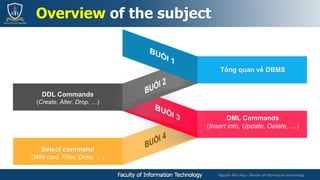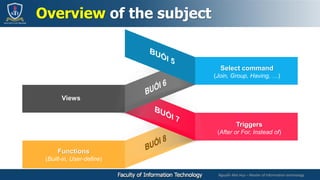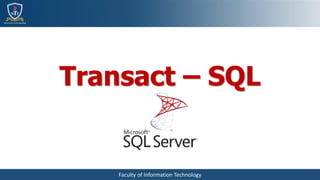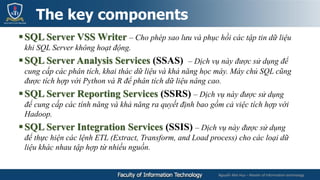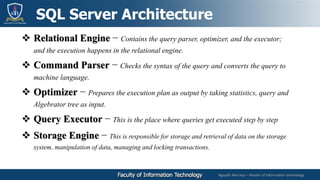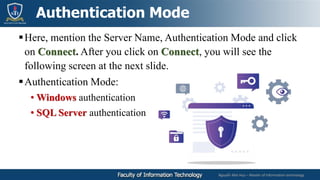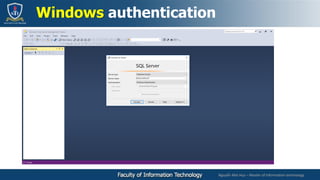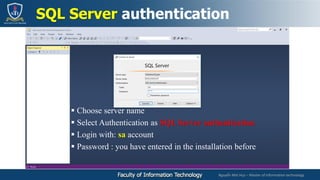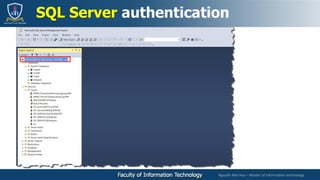00 overview of_sql_server
- 1. Overview of DBMS M├┤n hß╗Źc: Hß╗ć quß║Żn trß╗ŗ cŲĪ sŲĪ dß╗» liß╗ću [Buß╗Ģi 1] GV: Nguyß╗ģn Mai Huy
- 2. Faculty of Information Technology Nguyß╗ģn Mai Huy nmhuy@ntt.edu.vn 01 Thß║Żo luß║Łn + BT (10%) Kiß╗ām tra giß╗»a kß╗│ (30%) Thi tß╗▒ luß║Łn (60%) 03 T├Łn chß╗ē: 3 L├Į thuyß║┐t: 30 tiß║┐t Thß╗▒c h├Ānh: 30 tiß║┐t B├Āi tß║Łp: TH + ß╗× nh├Ā 02 ║▌║▌▀Ż B├Āi giß║Żng T├Āi liß╗ću tham khß║Żo (Cuß╗æi slide) 04
- 3. Nguyß╗ģn Mai Huy ŌĆō Master of Information technology Overview of the subject Tß╗Ģng quan vß╗ü DBMS DML Commands (Insert into, Update, Delete, ŌĆ”) DDL Commands (Create, Alter, Drop, ŌĆ”) Select command (Wild card, Filter, Order, ŌĆ”)
- 4. Nguyß╗ģn Mai Huy ŌĆō Master of Information technology Overview of the subject Select command (Join, Group, Having, ŌĆ”) Triggers (After or For, Instead of) Views Functions (Built-in, User-define)
- 5. Nguyß╗ģn Mai Huy ŌĆō Master of Information technology Overview of the subject Stored Procedure (Control-of-flow statements) ├ön tß║Łp, giß╗øi hß║Īn KT Stored Procedure (Cursors, Handling Exceptions) Thi kiß╗ām tra cuß╗æi hß╗Źc kß╗│
- 6. Faculty of Information Technology SQL Structured English Query Language
- 7. Nguyß╗ģn Mai Huy ŌĆō Master of Information technology ’é¦ SQL: "Ng├┤n ngß╗» truy vß║źn dß╗» liß╗ću c├│ t├Łnh cß║źu tr├║c" - l├Ā loß║Īi ng├┤n ngß╗» lß║Łp tr├¼nh cho m├Īy t├Łnh, phß╗źc vß╗ź cho c├Īc mß╗źc ─æ├Łch: Tß║Īo, Sß╗Ła, v├Ā Lß║źy dß╗» liß╗ću tß╗½ mß╗Öt hß╗ć quß║Żn trß╗ŗ cŲĪ sß╗¤ dß╗» liß╗ću quan hß╗ć (DBMS - Database Management System). ’é¦ Th├Īng 6 n─ām 1970, tß║Īp ch├Ł Communications of the ACM c├┤ng bß╗æ m├┤ h├¼nh A Relational Model of Data for Large Share Data Banks ("M├┤ h├¼nh quan hß╗ć cho dß╗» liß╗ću d├╣ng trong ng├ón h├Āng dß╗» liß╗ću chia sß║╗ c├│ khß╗æi lŲ░ß╗Żng lß╗øn") cß╗¦a tiß║┐n s─® Edgar F. Codd, m├┤ h├¼nh n├Āy sau ─æ├│ ─æ├Ż ─æŲ░ß╗Żc chß║źp nhß║Łn rß╗Öng r├Żi v├Ā ─æŲ░ß╗Żc xem l├Ā m├┤ h├¼nh ti├¬u chuß║®n d├╣ng cho hß╗ć thß╗æng quß║Żn l├Į cŲĪ sß╗¤ dß╗» liß╗ću quan hß╗ć. ’é¦ Giß╗»a nhß╗»ng n─ām 1970, mß╗Öt nh├│m chuy├¬n gia thuß╗Öc trung t├óm nghi├¬n cß╗®u cß╗¦a IBM tß║Īi San Jose ph├Īt triß╗ān hß╗ć thß╗æng cŲĪ sß╗¤ dß╗» liß╗ću "Hß╗ć thß╗æng R" dß╗▒a tr├¬n m├┤ h├¼nh cß╗¦a Codd, lß║źy t├¬n l├Ā Structured English Query Language, viß║┐t tß║»t l├Ā "SEQUEL" ("Ng├┤n ngß╗» truy vß║źn c├│ cß║źu tr├║c dß╗▒a tr├¬n tiß║┐ng Anh"), ng├┤n ngß╗» n├Āy ─æŲ░ß╗Żc thiß║┐t kß║┐ ─æß╗ā quß║Żn l├Į v├Ā truy xuß║źt dß╗» liß╗ću lŲ░u trß╗» trong ŌĆ£Hß╗ć thß╗æng RŌĆØ. Sau n├Āy, t├¬n viß║┐t tß║»t SEQUEL ─æŲ░ß╗Żc r├║t gß╗Źn th├Ānh SQL ─æß╗ā tr├Īnh viß╗ćc tranh chß║źp nh├Żn hiß╗ću (tß╗½ SEQUEL ─æ├Ż ─æŲ░ß╗Żc mß╗Öt c├┤ng ty m├Īy bay cß╗¦a UK l├Ā Hawker-Siddeley ─æ─āng k├Į trŲ░ß╗øc ─æ├│). ’é¦ Mß║Ęc d├╣ SQL bß╗ŗ ß║Żnh hŲ░ß╗¤ng bß╗¤i c├┤ng tr├¼nh cß╗¦a tiß║┐n s─® Edgar F. Codd nhŲ░ng n├│ lß║Īi ─æŲ░ß╗Żc thiß║┐t kß║┐ bß╗¤i Donald D. Chamberlin v├Ā Raymond F. Boyce tß║Īi IBM. History
- 8. Nguyß╗ģn Mai Huy ŌĆō Master of Information technology SQL ─æŲ░ß╗Żc thß╗½a nhß║Łn l├Ā ti├¬u chuß║®n cß╗¦a ANSI (American National Standards Institute) v├Āo n─ām 1986 v├Ā ISO (International Organization for Standardization) n─ām 1987. ANSI ─æ├Ż c├┤ng bß╗æ c├Īch ph├Īt ├óm ch├Łnh thß╗®c cß╗¦a SQL l├Ā "ess kyoo ell", nhŲ░ng rß║źt nhiß╗üu c├Īc chuy├¬n gia cŲĪ sß╗¤ dß╗» liß╗ću n├│i tiß║┐ng Anh vß║½n gß╗Źi n├│ l├Ā "SEQUEL". History N─ām T├¬n T├¬n kh├Īc Ch├║ giß║Żi 1986 SQL-86 SQL-87 ─ÉŲ░ß╗Żc c├┤ng bß╗æ ─æß║¦u ti├¬n bß╗¤i ANSI. ─ÉŲ░ß╗Żc ph├¬ chuß║®n bß╗¤i ISO n─ām 1987. 1989 SQL-89 Thay ─æß╗Ģi nhß╗Å. 1992 SQL-92 SQL2 Thay ─æß╗Ģi lß╗øn. 1999 SQL:1999 SQL3 2003 SQL:2003
- 9. Nguyß╗ģn Mai Huy ŌĆō Master of Information technology ’é¦Data Definition Language ŌĆō DDL (is used to define data structures stored in the database. DDL statements allow to create, modify or destroy individual database objects. Object types allowed depend on the DBMS used, and usually include databases, users, tables and some smaller housekeeping objects like roles and indexes.) ’é¦ Data Manipulation Language ŌĆō DML ( is used to query and change data stored in the database. DML statements allow to select, insert, update and delete data in the tables. Sometimes pure select statements are not classified as part of DML, since they donŌĆÖt change the state of the data. All SQL DML statements are declarative.) (CRUD: Create ŌĆō Retrieve ŌĆō Update ŌĆō Delete) ’üČ Create ŌĆō insert ’üČ Retrieve ŌĆō Read: select ’üČ Update ŌĆō Modify: update ’üČ Delete ŌĆō Destroy: delete Types of sub-language in SQL
- 10. Nguyß╗ģn Mai Huy ŌĆō Master of Information technology ’é¦ Data Control Language ŌĆō DCL ( is used to control access to data stored in the database. DCL statements operate with privileges and allow to grant and revoke privileges on applying certain DDL and DML commands to certain database objects.) ’é¦ Transaction Control Language ŌĆō TCL (is used to control processing of transactions in the database. Usual TCL statements are commit to apply the changes introduced by the transaction, rollback to undo them and savepoint to divide the transaction into several smaller parts.) Types of sub-language in SQL DDL DML TCL DCL SQL
- 11. Nguyß╗ģn Mai Huy ŌĆō Master of Information technology Database Management System ŌĆō DBMS : l├Ā ŌĆ£mß╗Öt dß║Īng phß║¦n mß╗ümŌĆØ cung cß║źp c├Īc chß╗®c n─āng cho ph├®p c├Īc phß║¦n mß╗üm (software), c┼®ng nhŲ░ ngŲ░ß╗Øi d├╣ng (end-user) c├│ thß╗ā thß╗▒c hiß╗ćn c├Īc h├Ānh ─æß╗Öng tŲ░ŲĪng t├Īc vß╗øi cŲĪ sß╗¤ dß╗» liß╗ću ─æ├Ż ─æŲ░ß╗Żc x├óy dß╗▒ng b├¬n trong n├│: Tß║Īo mß╗øi, LŲ░u trß╗», Chß╗ēnh sß╗Ła, X├│a bß╗Å, Truy vß║źn v├Ā Ph├ón t├Łch dß╗» liß╗ću ŌĆ” Th├┤ng thŲ░ß╗Øng, hß╗ć quß║Żn trß╗ŗ cŲĪ sß╗¤ dß╗» liß╗ću sß║Į tß╗▒ ─æß╗Öng gi├║p ngŲ░ß╗Øi d├╣ng kiß╗ām so├Īt th├┤ng tin v├Ā duy tr├¼ c├Īc CSDL. C├Īc th├Ānh phß║¦n ch├Łnh cß╗¦a mß╗Öt DBMS thŲ░ß╗Øng bao gß╗ōm: ’üČ Bß╗Ö xß╗Ł l├Į truy vß║źn (Query processor) ’üČ Bß╗Ö quß║Żn l├Ł dß╗» liß╗ću (Data management) DBMS ŌĆō Hß╗ć quß║Żn trß╗ŗ CSDL
- 12. Nguyß╗ģn Mai Huy ŌĆō Master of Information technology ’ü▒ Cung cß║źp m├┤i trŲ░ß╗Øng tß║Īo, ─æß╗ŗnh ngh─®a cŲĪ sß╗¤ dß╗» liß╗ću (Ng├┤n ngß╗» ─æß╗ŗnh ngh─®a dß╗» liß╗ću) ’ü▒ Cung cß║źp c├Īc t├Łnh n─āng cß║Łp nhß║Łt v├Ā khai th├Īc dß╗» liß╗ću (Ng├┤n ngß╗» thao t├Īc dß╗» liß╗ću) ’ü▒ Cho ph├®p kiß╗ām so├Īt, ─æiß╗üu khiß╗ān truy cß║Łp v├Āo CSDL (Ng├┤n ngß╗» kiß╗ām so├Īt dß╗» liß╗ću) Nhiß╗ćm vß╗ź ch├Łnh cß╗¦a DBMS
- 13. Nguyß╗ģn Mai Huy ŌĆō Master of Information technology SŲĪ ─æß╗ō hß╗ć thß╗æng DBMS
- 14. Nguyß╗ģn Mai Huy ŌĆō Master of Information technology ’üČ dBASE ’üČ FoxPro ’üČ Microsoft Access ’üČ MySQL ’üČ Microsoft SQL Server ’üČ SQLite ’üČ IBM DB2 ’üČ Oracle ’üČ PostgreSQL ’üČ . . . Mß╗Öt sß╗æ DBMS phß╗Ģ biß║┐n
- 15. Faculty of Information Technology Transact ŌĆō SQL
- 16. Nguyß╗ģn Mai Huy ŌĆō Master of Information technology Transact-SQL (T-SQL) l├Ā mß╗Öt mß╗¤ rß╗Öng ─æß╗Öc quyß╗ün cß╗¦a Microsoft v├Ā Sybase cho SQL d├╣ng ─æß╗ā tŲ░ŲĪng t├Īc vß╗øi cŲĪ sß╗¤ dß╗» liß╗ću quan hß╗ć. T-SQL mß╗¤ rß╗Öng dß╗▒a tr├¬n SQL ─æß╗ā cho ph├®p lß║Łp tr├¼nh thß╗¦ tß╗źc, khai b├Īo v├Ā sß╗Ł dß╗źng c├Īc biß║┐n cß╗źc bß╗Ö, c├Īc h├Ām hß╗Ś trß╗Ż kh├Īc nhau cho xß╗Ł l├Į chuß╗Śi, xß╗Ł l├Į ng├Āy, to├Īn hß╗Źc, ŌĆ” ─æß╗ōng thß╗Øi thay ─æß╗Ģi c├Īc lß╗ćnh DELETE v├Ā UPDATE. Transact-SQL l├Ā ng├┤n ngß╗» lß║Łp tr├¼nh quan trß╗Źng trong viß╗ćc khai th├Īc v├Ā sß╗Ł dß╗źng Microsoft SQL Server. Tß║źt cß║Ż c├Īc ß╗®ng dß╗źng giao tiß║┐p vß╗øi SQL Server ─æß╗üu thß╗▒c hiß╗ćn gß╗Łi c├Īc c├óu lß╗ćnh Transact-SQL dŲ░ß╗øi dß║Īng TEXT ─æß║┐n m├Īy chß╗¦ cŲĪ sß╗¤ dß╗» liß╗ću, v├Ā nhß║Łn vß╗ü kß║┐t quß║Ż thß╗▒c thi tr├¬n CSDL m├Ā kh├┤ng hß╗ü phß╗ź thuß╗Öc v├Āo giao diß╗ćn ngŲ░ß╗Øi d├╣ng cß╗¦a ß╗®ng dß╗źng. T-SQL
- 17. Nguyß╗ģn Mai Huy ŌĆō Master of Information technology C├│ 3 ─æiß╗ām kh├Īc biß╗ćt ch├Łnh giß╗»a SQL v├Ā T-SQL ’üČ SQL l├Ā 1 ng├┤n ngß╗» lß║Łp tr├¼nh, c├▓n T-SQL l├Ā mß╗Öt mß╗¤ rß╗Öng cß╗¦a SQL. ’üČ T-SQL cho ph├®p ŌĆ£lß║Łp tr├¼nh hŲ░ß╗øng thß╗¦ tß╗źcŌĆØ vß╗øi c├Īc biß║┐n cß╗źc bß╗Ö, c├▓n SQL th├¼ kh├┤ng. ’üČ T-SQL l├Ā ─æß╗Öc quyß╗ün, c├▓n SQL l├Ā mß╗Öt ŌĆ£─æß╗ŗnh dß║Īng mß╗¤ŌĆØ. SQL vs T-SQL
- 18. Nguyß╗ģn Mai Huy ŌĆō Master of Information technology Microsoft SQL Server l├Ā mß╗Öt hß╗ć thß╗æng quß║Żn l├Į cŲĪ sß╗¤ dß╗» liß╗ću quan hß╗ć ─æŲ░ß╗Żc ph├Īt triß╗ān bß╗¤i Microsoft. SQL Server hoß║Īt ─æß╗Öng nhŲ░ mß╗Öt m├Īy chß╗¦ cŲĪ sß╗¤ dß╗» liß╗ću, ─æ├óy l├Ā mß╗Öt sß║Żn phß║®m phß║¦n mß╗üm c├│ chß╗®c n─āng ch├Łnh l├Ā lŲ░u trß╗» v├Ā truy xuß║źt dß╗» liß╗ću theo y├¬u cß║¦u cß╗¦a c├Īc ß╗®ng dß╗źng phß║¦n mß╗üm kh├Īc, c├│ thß╗ā chß║Īy tr├¬n c├╣ng mß╗Öt m├Īy t├Łnh hay tr├¬n mß╗Öt m├Īy t├Łnh kh├Īc ─æß╗ōng thß╗Øi cho ph├®p kß║┐t nß╗æi th├┤ng qua mß║Īng m├Īy t├Łnh (bao gß╗ōm cß║Ż Internet). Microsoft cung cß║źp nhiß╗üu phi├¬n bß║Żn Microsoft SQL Server, nhß║»m v├Āo c├Īc ─æß╗æi tŲ░ß╗Żng kh├Īc nhau, cho c├Īc khß╗æi lŲ░ß╗Żng c├┤ng viß╗ćc kh├Īc nhau. Tß╗½ c├Īc ß╗®ng dß╗źng ─æŲĪn lß║╗, khß╗æi lŲ░ß╗Żng c├┤ng viß╗ćc nhß╗Å, cho ─æß║┐n c├Īc ß╗®ng dß╗źng lß╗øn vß╗øi nhiß╗üu ngŲ░ß╗Øi d├╣ng ─æß╗ōng thß╗Øi truy cß║Łp th├┤ng qua Internet. What is SQL Server?
- 19. Nguyß╗ģn Mai Huy ŌĆō Master of Information technology ’ü▒ MS SQL Server for OS/2 : 1989, by Sybase, Ashton-Tate, and Microsoft. ’ü▒ SQL Server 4.2 for NT : 1993. ’ü▒ SQL Server 6.0 : 1995 (Microsoft kß║┐t th├║c qu├Ī tr├¼nh hß╗Żp t├Īc vß╗øi Sybase, l├║c n├Āy Sybase tiß║┐p tß╗źc ph├Īt triß╗ān mß╗Öt biß║┐n thß╗ā kh├Īc Sybase Adaptive Server Enterprise, ─æß╗Öc lß║Łp vß╗øi Microsoft). ’ü▒ SQL Server 7.0 : 1998. ’ü▒ SQL Server 2005, (ho├Ān tß║źt viß╗ćc chuyß╗ān ─æß╗Ģi m├Ż c┼® do Sybase ph├Īt triß╗ān sang Microsoft). ’ü▒ SQL Server 2017, (bß╗Ģ sung c├Īc hß╗Ś trß╗Ż cho nß╗ün tß║Żng Linux) Ph├¬n bß║Żn & c├Īc mß╗æc quan trß╗Źng
- 20. Nguyß╗ģn Mai Huy ŌĆō Master of Information technology ’é¦Database Engine ŌĆō Th├Ānh phß║¦n ch├Łnh, c├│ nhiß╗ćm vß╗ź lŲ░u trß╗», xß╗Ł l├Į c├Īc giao dß╗ŗch vß╗øi tß╗æc ─æß╗Ö nhan v├Ā giß╗» nhiß╗ćm vß╗ź bß║Żo mß║Łt ─æß╗æi vß╗øi cŲĪ sß╗¤ dß╗» liß╗ću. ’é¦SQL Server ŌĆō ─É├óy l├Ā dß╗ŗch vß╗ź d├╣ng ─æß╗ā: Khß╗¤i ─æß╗Öng, Dß╗½ng, Tß║Īm ngŲ░ng hay tiß║┐p tß╗źc thi h├Ānh ─æß╗æi vß╗øi c├Īc ŌĆ£thß╗▒c thß╗āŌĆØ SQL Server. ’é¦SQL Server Agent ŌĆō Dß╗ŗch vß╗ź n├Āy sß║Į thß╗▒c thi c├Īc nhiß╗ćm vß╗ź ( role) theo lß╗ŗch tr├¼nh, hoß║Ęc tß╗▒ ─æß╗Öng thß╗▒c thi c├Īc nhiß╗ćm vß╗ź dß╗▒a tr├¬n c├Īc sß╗▒ kiß╗ćn c┼®ng nhŲ░ c├Īc y├¬u cß║¦u tß╗½ b├¬n ngo├Āi. ’é¦SQL Server Browser ŌĆō Dß╗ŗch vß╗ź n├Āy thŲ░ß╗Øng ─æŲ░ß╗Żc d├╣ng ─æß╗ā kß║┐t nß╗æi c├Īc y├¬u cß║¦u ─æŲ░ß╗Żc gß╗Łi ─æß║┐n tß╗½ b├¬n ngo├Āi vß╗øi SQL Server instance mong muß╗æn. ’é¦SQL Server Full-Text Search ŌĆō ─ÉŲ░ß╗Żc sß╗Ł dß╗źng ─æß╗ā cho ph├®p ngŲ░ß╗Øi d├╣ng chß║Īy c├Īc truy vß║źn ß╗¤ dß║Īng Full-Text ─æß╗æi vß╗øi dß╗» liß╗ću character trong c├Īc bß║Żng SQL. The key components
- 21. Nguyß╗ģn Mai Huy ŌĆō Master of Information technology ’é¦SQL Server VSS Writer ŌĆō Cho ph├®p sao lŲ░u v├Ā phß╗źc hß╗ōi c├Īc tß║Łp tin dß╗» liß╗ću khi SQL Server kh├┤ng hoß║Īt ─æß╗Öng. ’é¦SQL Server Analysis Services (SSAS) ŌĆō Dß╗ŗch vß╗ź n├Āy ─æŲ░ß╗Żc sß╗Ł dß╗źng ─æß╗ā cung cß║źp c├Īc ph├ón t├Łch, khai th├Īc dß╗» liß╗ću v├Ā khß║Ż n─āng hß╗Źc m├Īy. M├Īy chß╗¦ SQL c┼®ng ─æŲ░ß╗Żc t├Łch hß╗Żp vß╗øi Python v├Ā R ─æß╗ā ph├ón t├Łch dß╗» liß╗ću n├óng cao. ’é¦SQL Server Reporting Services (SSRS) ŌĆō Dß╗ŗch vß╗ź n├Āy ─æŲ░ß╗Żc sß╗Ł dß╗źng ─æß╗ā cung cß║źp c├Īc t├Łnh n─āng v├Ā khß║Ż n─āng ra quyß║┐t ─æß╗ŗnh bao gß╗ōm cß║Ż viß╗ćc t├Łch hß╗Żp vß╗øi Hadoop. ’é¦SQL Server Integration Services (SSIS) ŌĆō Dß╗ŗch vß╗ź n├Āy ─æŲ░ß╗Żc sß╗Ł dß╗źng ─æß╗ā thß╗▒c hiß╗ćn c├Īc lß╗ćnh ETL (Extract, Transform, and Load process) cho c├Īc loß║Īi dß╗» liß╗ću kh├Īc nhau tß║Łp hß╗Żp tß╗½ nhiß╗üu nguß╗ōn. The key components
- 22. Nguyß╗ģn Mai Huy ŌĆō Master of Information technology SQL Server Architecture
- 23. Nguyß╗ģn Mai Huy ŌĆō Master of Information technology SQL Server Architecture ’üČ Relational Engine ŌłÆ Contains the query parser, optimizer, and the executor; and the execution happens in the relational engine. ’üČ Command Parser ŌłÆ Checks the syntax of the query and converts the query to machine language. ’üČ Optimizer ŌłÆ Prepares the execution plan as output by taking statistics, query and Algebrator tree as input. ’üČ Query Executor ŌłÆ This is the place where queries get executed step by step ’üČ Storage Engine ŌłÆ This is responsible for storage and retrieval of data on the storage system, manipulation of data, managing and locking transactions.
- 24. Faculty of Information Technology SQL Server Management Studio
- 25. Nguyß╗ģn Mai Huy ŌĆō Master of Information technology SSMS from the start menu
- 26. Nguyß╗ģn Mai Huy ŌĆō Master of Information technology When you open the SQL server management studio from the start menu, a window will open similar to the window shown in the picture below. Accessing Database Engine
- 27. Nguyß╗ģn Mai Huy ŌĆō Master of Information technology ’é¦Here, mention the Server Name, Authentication Mode and click on Connect. After you click on Connect, you will see the following screen at the next slide. ’é¦Authentication Mode: ŌĆó Windows authentication ŌĆó SQL Server authentication Authentication Mode
- 28. Nguyß╗ģn Mai Huy ŌĆō Master of Information technology Windows authentication
- 29. Nguyß╗ģn Mai Huy ŌĆō Master of Information technology Windows authentication
- 30. Nguyß╗ģn Mai Huy ŌĆō Master of Information technology SQL Server authentication ’é¦ Choose server name ’é¦ Select Authentication as SQL Server authentication ’é¦ Login with: sa account ’é¦ Password : you have entered in the installation before
- 31. Nguyß╗ģn Mai Huy ŌĆō Master of Information technology SQL Server authentication
- 32. Nguyß╗ģn Mai Huy ŌĆō Master of Information technology ’é¦Ng├┤n ngß╗» truy vß║źn dß╗» liß╗ću c├│ cß║źu tr├║c : SQL ’é¦SQL & Transact SQL ’é¦C├Īc nh├│m lß╗ćnh ─æß║Ęc trŲ░ng cß╗¦a T-SQL ’é¦Microsoft SQL Server Management Studio (SSMS) ’é¦C├Īc h├¼nh thß╗®c truy cß║Łp v├Āo SQL Server ’é¦Hß╗ć quß║Żn trß╗ŗ cŲĪ sß╗¤ dß╗» liß╗ću :: DBMS ’é¦M├┤ h├¼nh truy xuß║źt dß╗» liß╗ću tr├¬n hß╗ć thß╗æng DBMS Nhß╗ø g├¼ ?!!!
- 33. Nguyß╗ģn Mai Huy ŌĆō Master of Information technology ’é¦ Itzik Ben-Gan, ŌĆ£Microsoft┬« SQL Server ┬« 2012 T-SQL FundamentalsŌĆØ, OŌĆÖReilly Media Inc, 2012 ’é¦ Itzik Ben-Gan, Dejan Sarka, Ed Katibah, Greg Low, Roger Wolter, and Isaac Kunen, ŌĆ£Inside Microsoft SQL Server 2008: T-SQL ProgrammingŌĆØ, Microsoft Press, 2010 ’é¦ w3schools, ŌĆ£Introduction to SQLŌĆØ, https://www.w3schools.com/sql/sql_intro.asp, 10:54PM, 18/06/2020 ’é¦ Microsoft SQL Server Tutorial, ŌĆ£Tutorials for SQL ServerŌĆØ, https://docs.microsoft.com/en-us/sql/sql-server/tutorials-for-sql-server-2016, 10:54 PM, 18/06/2020 T├Āi liß╗ću tham khß║Żo
![Overview of DBMS
M├┤n hß╗Źc: Hß╗ć quß║Żn trß╗ŗ cŲĪ sŲĪ dß╗» liß╗ću [Buß╗Ģi 1]
GV: Nguyß╗ģn Mai Huy](https://image.slidesharecdn.com/00overviewofsqlserver-210902090038/85/00-overview-of_sql_server-1-320.jpg)

